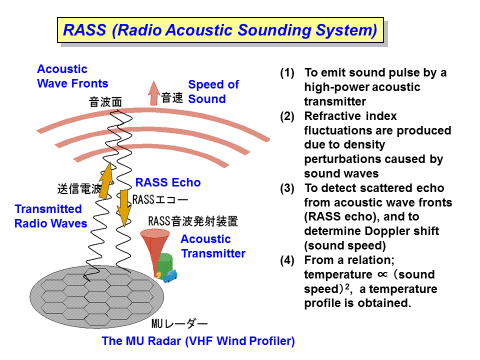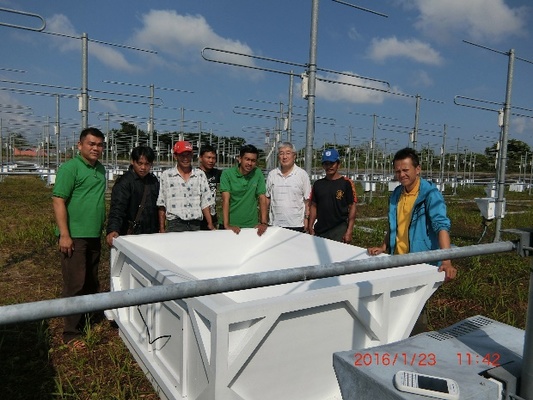研究課題
Study of atmospheric stability variations with EAR-RASS observations
EAR-RASS観測による大気安定度の変動に関する研究
研究組織
| 代表者 | Halimurrahman (LAPAN) |
|---|---|
| 共同研究者 | 津田敏隆(京都大学生存圏研究所) Ina Juaeni (ASC, LAPAN) 橋口浩之(京都大学生存圏研究所) Syafrijon (EAR, LAPAN) Ginaldi Ari Nugroho (ASC, LAPAN) SoniAuliaRahayu (ASC, LAPAN) |
| 関連ミッション |
|
研究概要
This study is concerned with continuous measurement of temperature (T) profiles in the tropical troposphere (up to about 15 km) by adopting a new radar remote sensing technique, called Radio Acoustic Sounding System (RASS), to the Equatorial Atmosphere Radar (EAR) at Koto Tabang, west Sumatra.
The atmospheric stability primarily depends on the temperature gradient (lapse rate, dT/dz), and it is closely related to stratified and unstable conditions of the atmosphere. Under an unstable condition, a lifted air parcel becomes warmer than the surrounding air, and this parcel could further ascent, because its density is thinner than the ambient air. Instability can be described by the bulk Richardson number, convective available potential energy (CAPE) and vertical wind shear. These indices are related to dT/dz and wind velocity variations. In the tropics, time variation of the stability is large and rapid, which sometimes produces abrupt development of a convective cloud with a heavy rain, inducing a severe weather hazard. Therefore, continuous monitoring of T profiles is keenly required.
Figure 1 explains the basic concept of RASS for measuring atmospheric temperature profiles. RASS consists of a wind profiling radar (WPR), such as EAR, and a high-power acoustic transmitter. We develop an effective sound source and install it in the EAR site (see Fig. 2). Large sound waves produce refractive index fluctuations during their upward propagation in the atmosphere. Then, EAR can detect radio wave scattering (RASS echo) and its Doppler shift. As the sound speed can be related to a square root of T, we can measure a temperature profile. We apply a ray-tracing technique of sound wave propagation in order to find an appropriate radar beam direction that satisfies the Bragg condition for RASS echoes.
We will conduct a campaign observation of EAR-RASS in September — November. (Exact periods depend on availability of EAR.) We will also launch balloon-borne radiosondes. Profiles of three components of wind velocity are measured at 2–15 km by the turbulence echo with EAR with time and height resolutions of a few min. and 150 m, respectively. RASS can observe T with the same resolutions. We will try to monitor T up to about 20 km, including the tropopause at around 15–17 km. Observed T results with RASS are compared with simultaneous radiosondes. First, we investigate performance of EAR-RASS in terms of measurement accuracy, height resolution, and the maximum measureable height. Then, using the observed results, we will study generation, development and dissipation of a convective cloud, focusing on the atmospheric stability variations.

Figure 1 Basic principle of RASS measurements

Figure 2 A specially designed speaker for a high-power acoustic transmitter system installed for the equatorial atmosphere radar (EAR).
ページ先頭へもどる
2016年8月4日作成


